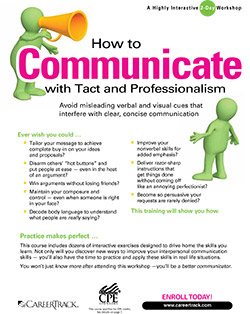Look around your organization. Who stands out as a true leader?
It’s the individuals who excel at one critical skill: effective communication.
The people who rise quickly through the ranks—the true influencers and decision-makers—share a unique ability to connect with others. They present ideas with confidence and charisma, navigate conversations with professionalism and consistently leave a positive impression.
The great news? These communication skills can be learned.
All successful leaders have one thing in common: they’ve mastered the art of tactful, impactful communication.
They know how to:
- Use diplomacy to build trust and resolve conflict—without force or friction
- Deliver messages clearly, so others "get it" the first time
- Show empathy while rallying support for their ideas
- Avoid miscommunication, arguments and repeated explanations
- Listen with intention—then act decisively
And now, they’re even smarter with how they communicate—by using AI tools like ChatGPT.
They use AI to:
- Craft professional, thoughtful responses in high-stakes or sensitive situations
- Polish messaging for clarity and tone
- Enhance workplace communication with speed and precision
Because in today’s professional world, how you say something is just as important as what you say.
Tactful communication is all about delivering your message with professionalism, clarity and purpose.
That’s what this two-day communication training is all about.
Through interactive coaching, real-world practice and personalized feedback, you’ll gain the skills to become a more persuasive, polished communicator.
You’ll walk away with:
- Greater confidence in handling tough conversations
- Proven strategies for influencing and inspiring others
- A deep understanding of workplace professionalism
- Tools to motivate, lead and collaborate more effectively
After two powerful days, you’ll be amazed at your growth—and excited to put your new skills into action.
